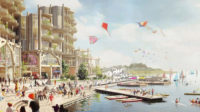Snøhetta’s New York office along with London’s Heatherwick Studio have released a series of renderings that conceptualize how mass timber construction could be deployed at a proposed redevelopment at Quayside, a 12-acre waterfront district east of downtown Toronto. Sidewalk Labs, a New York-based company that accelerates urban innovation, hired the two firms as it refined its 2017 competition-winning proposal for the site. Sidewalk’s proposal infuses the project with tech innovation and pioneers jobs development, advanced construction techniques, and financing strategies that disrupt the hidebound urban-development process.
Called Sidewalk Toronto, the project proposes 3 million square feet of mixed-use development on a brownfield site, including 3,000 apartments and a public plaza that wraps an inlet. A two-million-square-foot Google headquarters sweetens the deal (Sidewalk Labs is a subsidiary of Alphabet, the company that owns Google).
The proposed mid-rise and high-rise housing component, 40 percent of which is designated for below-market or low-income renters, would be erected with modular units of mass timber, helping the project to reach its Cradle-to-Cradle sustainability goals. Solar panels with battery storage—coordinated with a “thermal grid” of waste heat, as well as geothermal heating and cooling—minimize greenhouse-gas emissions. Additionally, the design features curbless streets to change the mix of autos, ride-sharing, and pedestrian space depending on demand.
Ground-floor spaces allow greater tenant flexibility (including office and community uses) and lower build-out costs. Operable facades are among techniques that blur the boundaries between the public realm and private space. To catalyze jobs, an urban innovation institute would combine research with new-businesses incubators, much the way Cornell Tech in New York City does.
Sidewalk Labs proposes finance innovations to realize these ambitions, which cannot be sustained by conventional development scenarios. It seeks to extend some of its innovations across the 190-acre Eastern Waterfront district, of which Quayside is a part to develop economies of scale. If the city agrees to the use of mass timber beyond the Quayside project, the larger scale will lower costs and could jump-start a mass-timber industry in Ontario. Alphabet and others may contribute some “patient capital” to the timber construction, the energy tactics, and the mobility innovations. Patient capital investors accept longer payback periods than the cycles preferred by conventional developers.
To move forward, Sidewalk’s proposal, which will be fully fleshed out in the next few months, must be approved by the client, Waterfront Toronto, a public-development entity comprising the governments of Canada, Ontario, and Toronto.
The emerging technologies, the novel economic-development tactics, and new financing tools have spurred skeptics who question whether the benefits promised are fair, transparent, and realistic. To address the pervasive mistrust of the way technology companies use data their devices collect, Sidewalk has proposed a Civic Data Trust that establishes an independent entity to manage data and rules for its use. “We know that building trust in the months and years ahead will be critical,” wrote Sidewalk chairman and CEO Daniel Doctoroff in a Toronto Star editorial.
Unlike companies such as Uber and Airbnb, which have imposed new technologies on cities without public participation, and with plenty of unintended consequences, Sidewalk Toronto has prioritized community engagement. The idea is to avoid surprises such as those sprung on New York City residents in the secretly negotiated Amazon headquarters deal that was recently squashed, in large part, by activist resistance.
Tech company missteps elsewhere may boost Sidewalk’s prospects, but its broad ambitions could still sink the project. Should that happen, will Google build its headquarters in Toronto? According to a Sidewalk spokesman, it’s a package deal.










Post a comment to this article
Report Abusive Comment